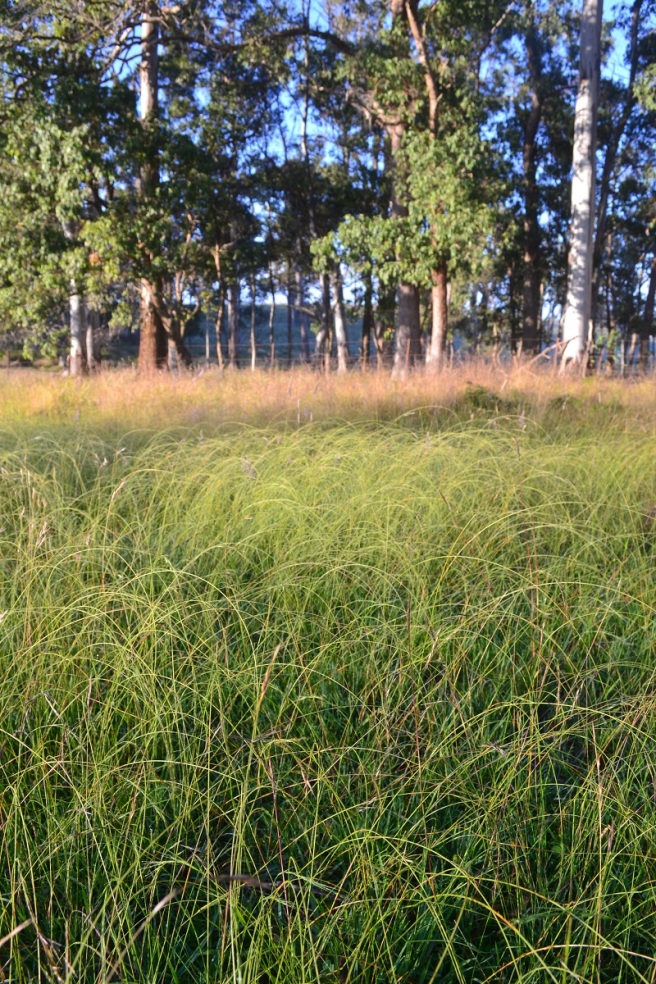The old man told me that as a young botanist circa 1970 he surveyed the pasture grasses of the NSW western slopes. Apparently he was particularly interested in the native grasses, but his superiors weren’t so impressed by this focus (he says) and he didn’t continue in that job.
Australian pasture grasses are still underappreciated and poorly understood. Many graziers prefer introduced grasses, including disastrous weeds like Buffel grass.
Recently, Dad got me a secondhand copy of Fred Turner‘s 1895 book Australian Grasses (with illustrations). A few people are beginning to appreciate Australia’s native grass landscapes for not only their ecology but in some cases as drought-hardy plants for grazing livestock. Turner noted this exact potential in many native grasses, and promoting them was a major part of his book. It’s amazing (if a little depressing) how many of the themes he introduced 120 years ago are still current.
Despite the practical focus of his book, providing feed for commercial livestock operations, you can’t help but notice that Turner also had an appreciation of the native plants in their own right. Having previously written a volume on native saltbushes (also very valuable for livestock fodder), he considered a combination of saltbush and grasses ideal for stock in many areas. If his recommendations had been followed in 1895, native grasslands might be in better shape – or at least, we might have more reserves of them – and perhaps there would be less exotic weed invasions and drought-induced soil losses.
Consider this key paragraph from his introduction (page xviii):
It will be gathered from this review of the indigenous herbage that there is in this country some splendid material to conserve and cultivate, and it only awaits intelligent management to clothe our pastoral areas with herbage if not like their pristine grandeur, to, at least, make them far more valuable possessions than they are at the present time. As a preliminary undertaking towards the conservation of indigenous grasses, salt-bushes and other herbage, reserves should be established in various parts of the country for the purpose of raising seeds to be disseminated in places where the herbage has been eaten out. Such reserves need not occupy large areas. It is astonishing the quantity of seed that can be harvested from a few acres. It would be a wise thing for the Governments of the Australian colonies to make grass reserves a compulsory undertaking when granting new leases for Crown lands. That such reserves would have a most beneficial effect upon the pastoral areas in this country cannot be gainsaid by thinking persons. In fact, there is already valuable data to work upon. All the railway enclosures throughout the country are excellent reserves for the preservation of the indigenous grasses and other herbage, and the most superficial observer cannot fail to have seen the amount of seed that is matured and distributed on the adjacent land by winds and other agencies. When this seed germinates it cannot fail to enhance the grazing capabilities of the pastures for miles around.
He went on to recommend rotational grazing on smaller paddocks, especially for sheep:
I would recommend the small-paddock system in country that is suited for pasturing sheep, and where the natural herbage is still fairly plentiful. For those areas which have deteriorated so much that sheep have a difficulty to eke out an existence it would be a wise thing to rest them for a period until the better kinds of herbage recuperate…
…I would certainly not recommend any larger than 2,000 acres, smaller areas being preferable. The paddocks should be so arranged that each one should have at least from three to four months’ rest in a year. This would give the herbage an opportunity to produce seed, which in time would germinate, and new plants would spring up to cover the ground.
The introduction is followed by assessments of the pasture in three areas of NSW (Illawarra; New England; Camden and Picton). The bulk of the book is taken up with species descriptions, including high quality line drawings. Many species names have changed: Kangaroo grass Themeda triandra was then Anthistiria ciliata. Others are still the same (eg Dichelachne crinita).

Whether the book is of current practical use I’m not sure, but as a historical perspective on modern agroecology it is a worthwhile read. Someone has scanned the text (without much editing) and made it available as Full text of “Australian Grasses (With Illustrations)” only without illustrations, sadly (good enough to read the introduction, anyway!).
EDIT: Helen King has pointed out in comments below that you can download a scanned version of the book, with illustrations, as a PDF here.

Such rich prose, wonderful words. Love the idea of seed raising reserves in places nobody values such as along railway reserves. This could be a positive Landcare project.
LikeLike
this site has the scanned book with illustrations
Click to access australiangrasse00turnrich.pdf
LikeLiked by 1 person
Thanks! That might come in very handy. Especially those line drawings!
LikeLike